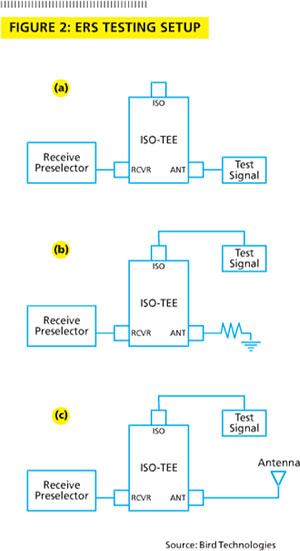How to test
Testing for high-level signals can be as easy as using a spectrum analyzer and antenna at the proposed location. As with any test using a spectrum analyzer and an input from the environment, proper band-pass filtering is required. Ideally, you would use the same band-pass filtering that will be utilized in the final system design.
In general, any carriers in excess of -60 dBm* should be identified and provided to the manufacturer that is designing the receive preselector. They can then use that information to give you an accurate idea of what it would take to protect your receivers from those high-level carriers. In some cases, this may result in a significant redesign of the receive-preselector network.
Measuring noise levels can be a little trickier than measuring high-level signals. Because noise is often very low relative to signal strengths in the area, any spectrum analyzer used will require a low-noise amplifier and filtering capable of measuring signals as low as -130 dBm.* Unfortunately, this often can be difficult for systems with complex frequency plans that require sharp filtering. Crystal filters work well, but they are expensive and very frequency-limited.
However, testing also can be performed with a typical system receiver to provide an idea of what kind of degradation a system would experience. Called “effective receiver sensitivity,” this testing can be performed with a sample receive system — including an antenna, receive preselector and multicoupler, and a radio — a service monitor, an isolated tee and a way to measure sensitivity. Sensitivity is normally measured in terms of bit-error rate (BER) for digital systems or SINAD for analog systems.
 The first step is to obtain the baseline (or static) sensitivity of the system. Place the isolated tee on the input or antenna for the receive preselector (Figure 2a). Then, inject a test signal from the service monitor into the antenna port of the isolated tee. The test signal is normally modulated by single tone for SINAD or a test pattern, such as V.52, for BER. Adjust the signal until you achieve either 5% BER or 12 dB SINAD. This signal level is your static sensitivity.
The first step is to obtain the baseline (or static) sensitivity of the system. Place the isolated tee on the input or antenna for the receive preselector (Figure 2a). Then, inject a test signal from the service monitor into the antenna port of the isolated tee. The test signal is normally modulated by single tone for SINAD or a test pattern, such as V.52, for BER. Adjust the signal until you achieve either 5% BER or 12 dB SINAD. This signal level is your static sensitivity.
The next step is to characterize the isolated tee. This is done by placing a load on the antenna port of the isolated tee and injecting the test signal onto the isolated port (Figure 2b). Once again, adjust the signal to achieve either 5% BER or 12 dB SINAD. This is our static sensitivity through the isolated port.
The last step is to attach an antenna to the antenna port of the isolated tee (Figure 2c). The signal required to achieve 5% BER or 12 dB SINAD through the isolated port likely will be higher than in the previous step. Assuming that the static-sensitivity measurement is close to what the final system will have, the difference in signal level between the second and third tests will represent the degradation caused by the external environment, and this difference can be subtracted from the static measurement in step one to obtain the effective receiver sensitivity (ERS).
Testing a site for both signal and noise interference before installation is like an insurance policy. It identifies external interference that may make it impossible for the system to perform as well as planned. Spending the extra time up front is worth it. Waiting until after design and installation to find out whether there’s a potentially crippling level of interference is a risky prospect. A little bit of time and effort spent to measure external interference before installation could prevent a world of hurt from an inoperable system.
Noise is unpredictable. We’ve performed noise readings at hundreds of sites in all of the LMR bands and, while we have a general idea of what to expect, there still doesn’t appear to be a solid figure that can be used for any given band. Without actual measurement, the best that can be done is to use a conservative estimate for noise levels that likely will not be exceeded.
In environments where the noise is lower than this conservative estimate, system designs may be overly complex and expensive. On the other hand, under-compensating for noise can lead to failed coverage tests and the need to add more sites. Isn’t it better just to know?
Bill Tobin works for Bird Technologies as an RF engineer for the Site Optimization Services group. He has more than seven years of experience solving on-site RF issues.













